Katsushika Hokusai and Utagawa Hiroshige are the top Japanese Ukiyo-e Japanese woodblock print artists. Both of these Japanese woodblock print artists are known worldwide.
Hokusai and Hiroshige were two great Japanese Ukiyo-e artists. Even though they both lived during the same time in Japan and painted similar subject matter, how they painted and saw that subject matter is very different. Hokusai was considered a bohemian artist, while Hiroshige was the ultimate Japanese government bureaucrat.
Table of Contents
- About Katsushika Hokusai Vs. Utagawa Hiroshige
- Katsushika Hokusai Vs. Utagawa Hiroshige Art Differences Explained
- Frequently Asked Questions
- Related Questions
About Katsushika Hokusai Vs. Utagawa Hiroshige
Katsushika Hokusai was born in 1760 and died in 1849. Utagawa Hiroshige was born in 1797 and died in 1858. Even though Hokusai was much older than Hiroshige, they both worked with the Japanese Ukiyo-e style of woodblock prints.
Even though they are considered some of the most famous Japanese Ukiyo-e woodblock print artists, their approach to the art is very different. Nowhere does this approach show more differently than the personalities of these two great artists.
Hokusai – The True Japanese Bohemian Artist

Hokusai was an independent kind of bohemian artist. Legends tell us that Hokusai would live in a place that he never bothered to clean; when it became dirty, he would move to a new location.
Hokusai moved from house to house many times as he was unwilling to clean any place where he lived. Hokusai is thought to have had over 100 different dwellings or places of residence throughout his life.
One story of Hokusai is told of how a government official came to visit Hokusai to offer him a commission. Hokusai’s house was so messy that there was no place for the government official to sit. Hokusai was not embarrassed, and in fact, he scolded the government official for his total lack of manners in not ignoring the mess.
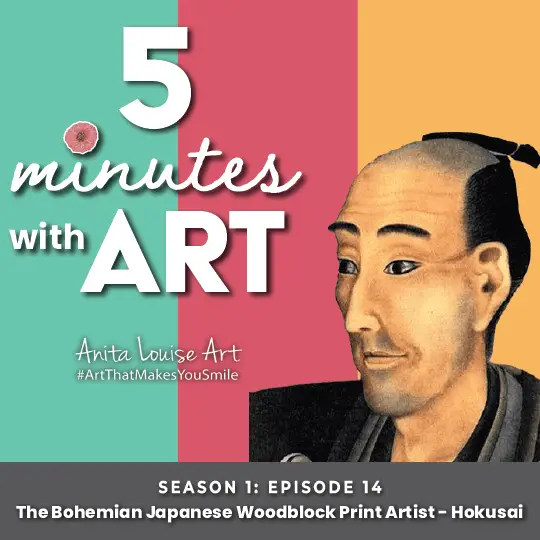
Listen To Our Podcast About The Bohemian Japanese Woodblock Print Artist – Hokusai
Hokusai got so upset with this government official who was upset with the messy house and having nowhere to sit that he told him he would not paint anything for him unless he apologized and told everyone he met that the house of Hokusai was a “model house of cleanliness.”
Hokusai changed his houses frequently, but he also changed his artistic names. Sometimes, he would sign his name as “Old Man Mad About Painting.”
Hokusai must have seemed mad to the people who knew him during his time. But no one can doubt he was a brilliant artist.
A story was told about how Hokusai was asked to paint maple leaves floating on the Tatsuta River for the Shogun. He visited the Shogun and drew a few blue lines on a piece of paper and then he put red paint on some chicken’s feet and started to chase the chickens are they ran around the paper.
Hokusai was a temperamental, eccentric outsider and loner – a Japanese Bohemian artist. But Hokusai was also a brilliant artist.
Utagawa (Ando Tokutaro) Hiroshige – The Government Bureaucrat
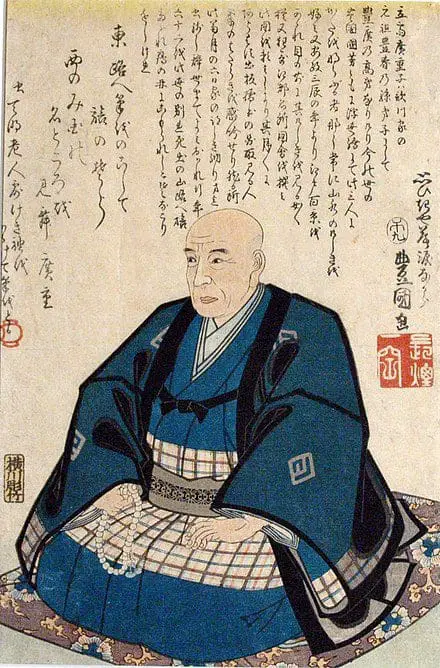
Hiroshige was born Ando Tukutaro to a low-ranking middle-class Japanese Samurai family. His father was more of an administrator than a Samurai warrior. His father worked for the firefighter league, and this was a job that Hiroshige inherited at age 13 when his father died.
It was from his art teacher Utagawa Toyohiro that he received his new name of Utagawa Hiroshige.
Utagawa never ceased to be a Japanese bureaucrat, even after he was able to support himself with his art. He was the opposite of Hokusai, as Hiroshige was the same as those who commissioned his art as part of the Japanese bureaucracy and government system.
Katsushika Hokusai Vs. Utagawa Hiroshige Art Differences Explained
There probably could not be two Japanese woodblock print artists as different in style and personality as Hokusai and Hiroshige. Hiroshige was said to paint what he saw in front of him, whereas Hokusai would adjust or manipulate things to fit his paintings and style.
We can see this best by comparing three similar subject matters that they both painted and how different they each are. Both Hokusai and Hiroshige painted Mount Fuji, Waterfall, and Birds and Flowers.

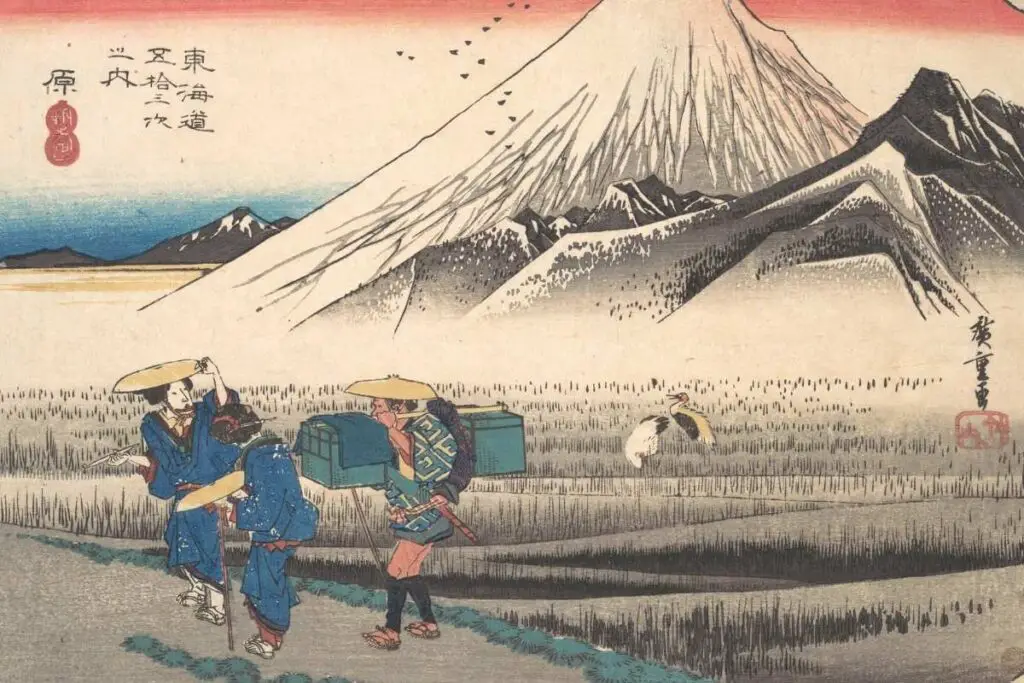
Mount Fuji (Fujiyama) – Hokusai Vs. Hiroshige
Both Hokusai and Hiroshige painted Mount Fuji. This would have been a popular subject for many Japanese artists.
Hokusai became famous for his Ukiyo-e “Thirty-six Views of Mount Fuji,” as he drew Mount Fuji from different angles and locations. His focus was not as much on Mount Fuji as was on the surrounding landscape, people, and events. In his paintings, Mount Fuji is more in the background of daily life.
After Hokusai’s success, Hiroshige also released his own “Thirty-six Views of Fuji.” His style is very different as his illustrations are more realistic, and Mount Fuji is always prominent and much more significant. Our main focal view is Mount Fuji.
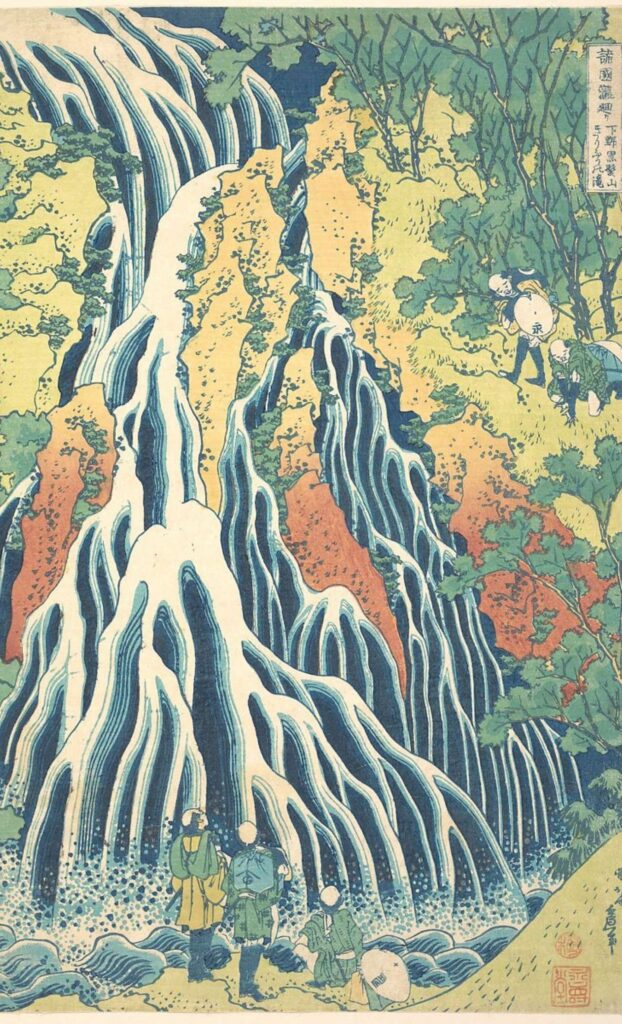

Waterfalls – Hokusai Vs. Hiroshige
After his woodblock prints of Mount Fuji were so successful, Hokusai decided to paint a series of waterfalls named “Waterfalls In Various Provinces.” He would show water falling by using swelling and splashing events. Hokusai’s fame increased after this series of woodblock prints.
Hiroshige’s style was making the woodblock prints seem as real as possible and making the viewer feel like they were right with the waterfall. His woodblock prints of the waterfalls are far more realistic than Hokusai’s woodblock prints.
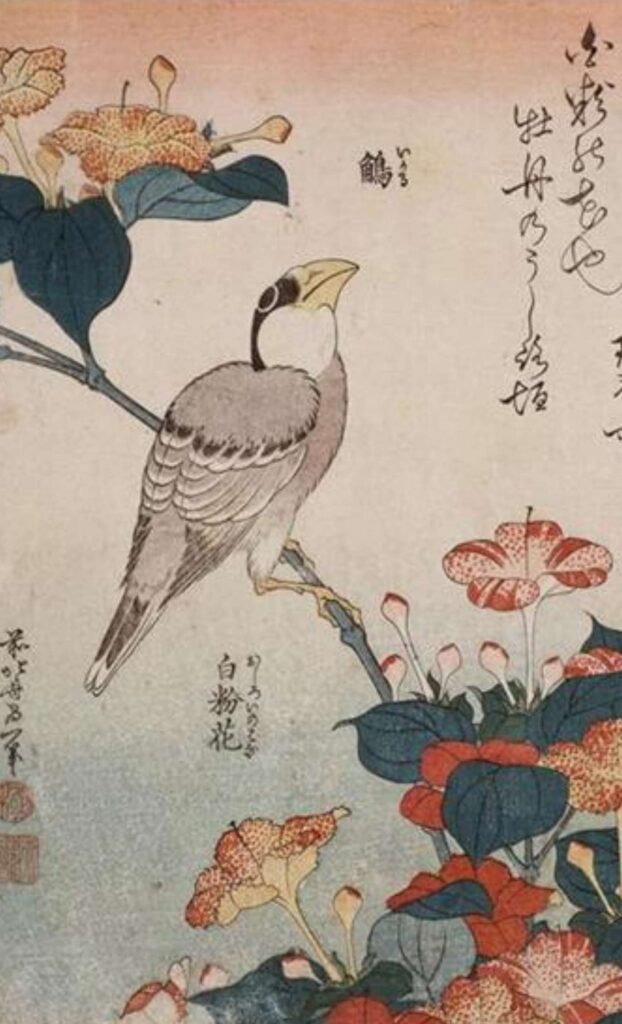
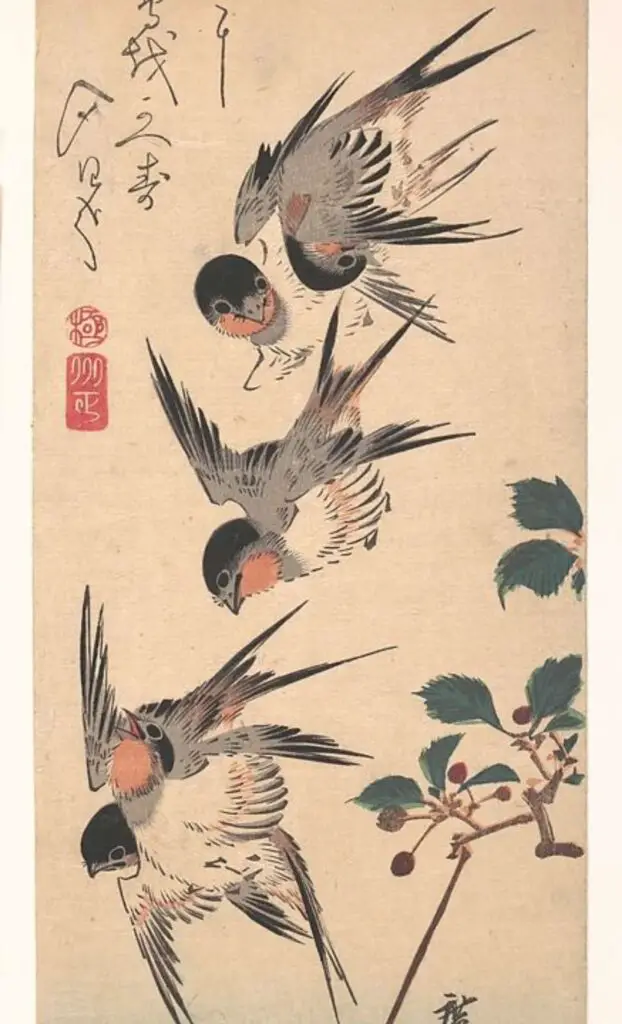
Bird and Flower Paintings – Hokusai Vs. Hiroshige
We can also see the difference in the paintings in how Hokusai and Hiroshige painted birds and flowers. The subject of birds and flowers was a popular subject for both artists. But even here, their works of art and how they handle the same subject matter are very different.
In the paintings above, you can see the difference in how they both painted flowers and birds, similar but at the same time very differently.
Hokusai and Hiroshige are considered two of the most significant Japanese artists ever to live, especially during the Japanese Ukiyo-e woodblock print period. They were both brilliant artists who brought their unique personalities, observations, and understanding to their artwork.
Frequently Asked Questions
How did Hokusai and Hiroshige contribute to the Ukiyo-e genre of Japanese woodblock prints?
Explore the unique styles and themes that each artist brought to the Ukiyo-e tradition, highlighting their individual contributions to this popular art form.
What distinguishes Hokusai’s artistic style from Hiroshige’s in Japanese woodblock art?
Delve into the distinctive techniques, brushstrokes, and visual elements that set apart Hokusai’s and Hiroshige’s works, showcasing the nuances that define their respective styles.
How did Hokusai’s bohemian lifestyle influence his artistic expression compared to Hiroshige’s bureaucratic background?
Examine the impact of their contrasting lifestyles on their artistic perspectives, shedding light on how personal experiences and societal roles shaped their creative output.
What are the common themes explored by both artists in their Japanese woodblock prints?
Explore the shared subjects and motifs that captivated both Hokusai and Hiroshige, uncovering the cultural and historical aspects that influenced their choice of themes.
How did Hokusai and Hiroshige depict landscapes differently in their Ukiyo-e prints?
Analyze the portrayal of landscapes in their works, focusing on the varied interpretations, compositions, and atmospheres created by each artist in their depictions of nature.
Were there any collaborative works or interactions between Hokusai and Hiroshige in the realm of Japanese woodblock art?
Investigate whether these two prominent artists collaborated or influenced each other’s work, exploring potential intersections in their artistic journeys.
How did Hokusai and Hiroshige contribute to the international recognition of Japanese woodblock prints?
Discuss the global impact of their artworks, examining how their prints gained popularity beyond Japan and contributed to the worldwide fascination with Ukiyo-e.
What role did Hokusai’s famous series “Thirty-Six Views of Mount Fuji” and Hiroshige’s “Fifty-Three Stations of the Tōkaidō” play in their artistic legacies?
Explore the significance of these iconic series in the artists’ careers, discussing how they influenced the perception of Japanese woodblock prints and left a lasting impact on art history.
How did societal and political factors in 19th-century Japan influence the artistic choices of Hokusai and Hiroshige?
Examine the historical context of their lives and the broader Japanese society during their time, highlighting how political and cultural changes may have influenced their artistic expressions.
What is the legacy of Hokusai and Hiroshige in contemporary art and popular culture?
Explore how the works of these two artists continue to inspire and influence modern artists, as well as their enduring presence in popular culture, museums, and art collections around the world.
Anita Louise Art is dedicated to art education, great artists, and inspiring others to find and create their art. We love art that uplifts and inspires. #ArtToMakeYouSmile! #ArtToMakeYouHappy!
If you are interested in seeing any of my art, you can find out more by clicking here. If you are interested in what inspires me and my paintings, you can discover more by clicking here.
We have a free newsletter and would love you to be part of our community; you can subscribe to the newsletter by clicking here. If you have any questions, I would be happy to talk to you at any time. You can reach me, Anita, by clicking here.
Subscribe to our Anita Louise Art YouTube Channel filled with great videos and information by clicking here.
Related Questions
Claude Monet And His Art Work
Claude Monet was one of the more prolific and consistent Impressionism painters. He was a great believer in painting what is in nature and painting the changing light. He was an en Plein air painter. He is known for his strong and bold colors and short brush strokes.
By clicking here, you can learn more by reading Claude Monet And His Art Work.
Claude Monet And The Rise of Japonisme
Japan opened its doors to the Western world for trade in 1853, and with that came a flood of Japanese art, artifacts, and textiles to Europe. Many Impressionism artists were fascinated with Japan, but one that was heavily influenced was Claude Monet.
By clicking here, you can learn more by reading Claude Monet And The Rise of Japonisme.
What Does Japonisme Mean?
The term Japonisme is about the influence of Japanese art on European culture and arts. Most notably, the influence Japanese woodblock prints had on the Impression art movement. Many of the prominent artists from the Impressionism art movement were inspired by the Japanese Ukiyo-e woodblock print artists.
By clicking here, you can learn more by reading What Does Japonisme Mean?.


